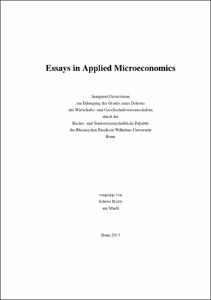Dato, Simon: Essays in Applied Microeconomics. - Bonn, 2022. - Dissertation, Rheinische Friedrich-Wilhelms-Universität Bonn.
Online-Ausgabe in bonndoc: https://nbn-resolving.org/urn:nbn:de:hbz:5-67117
Online-Ausgabe in bonndoc: https://nbn-resolving.org/urn:nbn:de:hbz:5-67117
@phdthesis{handle:20.500.11811/9974,
urn: https://nbn-resolving.org/urn:nbn:de:hbz:5-67117,
author = {{Simon Dato}},
title = {Essays in Applied Microeconomics},
school = {Rheinische Friedrich-Wilhelms-Universität Bonn},
year = 2022,
month = jun,
note = {This thesis consists of four independent research papers. Chapter 1 analyzes the impact of consumer myopia on competition and firm behavior. In our model, firms repeatedly sell a primary good and a respective add-on. In particular, we study what impact consumer myopia in the add-on market has on pricing behavior and on the ability of firms to engage in collusion. We show that in a situation in which firms cartelize and charge monopoly prices, limited attention makes deviation from such collusive behavior less rewarding and hence facilitates collusion. In particular, we determine the incentives of firms to educate consumers. We find that a shrouded market in which no firm educates consumers is a sign for cartelization. Hence, the observed obfuscation in a market can serve as a proxy signal for illegal industry agreements.
In chapter 2, we study the differences in behavior of males and females in a two-player tournament with sabotage in a controlled lab experiment. Implementing a real-effort design and a principal who is paid based on the agent’s output, we find that males and females do not differ in their performance in the real effort task but in their choice of sabotage. Males select significantly more sabotage, leading to an, on average, higher winning probability but not to higher profits. If the gender of the opponent is revealed before the tournament, males increase their performance in the real-effort task especially if the opponent is female. The gender gap in sabotage is persistent. We discuss possible explanations for our findings and their implications.
Chapters 3 and 4 analyze the behavior of expectation-based loss averse individuals in settings of strategic interaction. Chapter 3 shows that for loss-averse players with choice-acclimating expectations, the utility from playing a mixed strategy is not linear but convex in the probabilities they assign to their pure strategies. As a consequence, they are generally unwilling to randomize and an equilibrium may fail to exist. For players with choice-unacclimating expectations, by contrast, randomizing over their pure strategies may indeed constitute a credible best response and an equilibrium always exists. Building upon these insights, we delineate how expectation-based loss-averse players differ in their strategic behavior from their counterparts with standard expected-utility preferences, derive novel strategic effects, discuss equilibrium selection, and derive equilibrium play for some simple games.
In chapter 4 we analyze rank-order tournaments and show that under choice-unacclimating expectations both symmetric and asymmetric equilibria exist for all degrees of loss aversion. Importantly, a symmetric equilibrium also exists if players follow their preferred credible plan and the weight attached to psychological gain–loss utility does not strongly outweigh the weight put on material utility. Hence, for fixed expectations a focus on symmetric equilibria seems justifiable even if contestants are expectation-based loss averse.},
url = {https://hdl.handle.net/20.500.11811/9974}
}
urn: https://nbn-resolving.org/urn:nbn:de:hbz:5-67117,
author = {{Simon Dato}},
title = {Essays in Applied Microeconomics},
school = {Rheinische Friedrich-Wilhelms-Universität Bonn},
year = 2022,
month = jun,
note = {This thesis consists of four independent research papers. Chapter 1 analyzes the impact of consumer myopia on competition and firm behavior. In our model, firms repeatedly sell a primary good and a respective add-on. In particular, we study what impact consumer myopia in the add-on market has on pricing behavior and on the ability of firms to engage in collusion. We show that in a situation in which firms cartelize and charge monopoly prices, limited attention makes deviation from such collusive behavior less rewarding and hence facilitates collusion. In particular, we determine the incentives of firms to educate consumers. We find that a shrouded market in which no firm educates consumers is a sign for cartelization. Hence, the observed obfuscation in a market can serve as a proxy signal for illegal industry agreements.
In chapter 2, we study the differences in behavior of males and females in a two-player tournament with sabotage in a controlled lab experiment. Implementing a real-effort design and a principal who is paid based on the agent’s output, we find that males and females do not differ in their performance in the real effort task but in their choice of sabotage. Males select significantly more sabotage, leading to an, on average, higher winning probability but not to higher profits. If the gender of the opponent is revealed before the tournament, males increase their performance in the real-effort task especially if the opponent is female. The gender gap in sabotage is persistent. We discuss possible explanations for our findings and their implications.
Chapters 3 and 4 analyze the behavior of expectation-based loss averse individuals in settings of strategic interaction. Chapter 3 shows that for loss-averse players with choice-acclimating expectations, the utility from playing a mixed strategy is not linear but convex in the probabilities they assign to their pure strategies. As a consequence, they are generally unwilling to randomize and an equilibrium may fail to exist. For players with choice-unacclimating expectations, by contrast, randomizing over their pure strategies may indeed constitute a credible best response and an equilibrium always exists. Building upon these insights, we delineate how expectation-based loss-averse players differ in their strategic behavior from their counterparts with standard expected-utility preferences, derive novel strategic effects, discuss equilibrium selection, and derive equilibrium play for some simple games.
In chapter 4 we analyze rank-order tournaments and show that under choice-unacclimating expectations both symmetric and asymmetric equilibria exist for all degrees of loss aversion. Importantly, a symmetric equilibrium also exists if players follow their preferred credible plan and the weight attached to psychological gain–loss utility does not strongly outweigh the weight put on material utility. Hence, for fixed expectations a focus on symmetric equilibria seems justifiable even if contestants are expectation-based loss averse.},
url = {https://hdl.handle.net/20.500.11811/9974}
}






